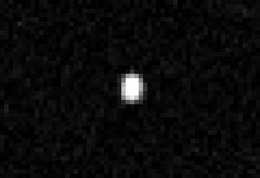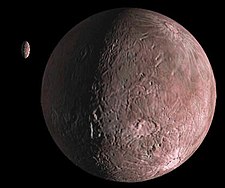50000 Quaoar

Sum of 16 Hubble exposures registered
on Quaoar in 2002 |
|
| Discovery | |
|---|---|
| Discovered by | Chad Trujillo, Michael Brown |
| Discovery date | 2002 Jun 05 10:48:08 PDT on an image taken 2002 June 04 05:41:40 UT |
| Designations | |
| Pronunciation | /ˈkwɑːwɑːr/ |
|
Named after
|
Quaoar |
| 2002 LM60 | |
| Cubewano | |
| Orbital characteristics | |
| Epoch 13 January 2016 (JD 2457400.5) | |
| Uncertainty parameter 3 | |
| Observation arc | 22578 days (61.82 yr) |
| Aphelion | 44.878 AU (6.7137 Tm) |
| Perihelion | 41.868 AU (6.2634 Tm) |
| 43.373 AU (6.4885 Tm) | |
| Eccentricity | 0.034704 |
| 285.65 yr (104334 d) | |
|
Average orbital speed
|
4.52 km/s |
| 287.542° | |
| 0° 0m 12.422s / day | |
| Inclination | 7.9870° |
| 188.772° | |
| 155.246° | |
| Known satellites |
Weywot (81±11 km in diameter) |
| Earth MOID | 40.8601 AU (6.11258 Tm) |
| Jupiter MOID | 36.8936 AU (5.51920 Tm) |
| Jupiter Tisserand parameter | 5.835 |
| Physical characteristics | |
| Dimensions |
1110±5 km (occultation) 1074±38 km |
| Mass |
(1.4±0.1)×1021 kg 0.12 Eris masses |
|
Mean density
|
1.99±0.46 g/cm3 2.18+0.43 −0.36 g/cm3 |
|
Equatorial surface gravity
|
0.276–0.376 m/s2 |
|
Equatorial escape velocity
|
0.523–0.712 km/s |
| 17.6788 h (0.73662 d) | |
|
Sidereal rotation period
|
17.6788 h |
| 0.109±0.007 | |
| Temperature | ≈ 43 K |
| (moderately red) B−V=0.94, V−R=0.64 |
|
| 19.3 | |
| 2.82±0.06, 2.4 | |

A moderately red Quaoar and its moon Weywot (artist's conception)
|
|
| Discovery | |
|---|---|
| Discovered by | Michael E. Brown |
| Discovery date | February 22, 2007 |
| Designations | |
| MPC designation | (50000) Quaoar I Weywot |
| Pronunciation | /ˈweɪwɒt/ |
| S/2006 (50000) 1 | |
| Orbital characteristics | |
| ~14 500 km | |
| Eccentricity | 0.14 ± 0.04 |
| 12.438 ± 0.005 d | |
| Inclination | 14±4 or 150±4 (two solutions) |
| Satellite of | Quaoar |
| Physical characteristics | |
|
Equatorial radius
|
40 ± 5 km ~37 km (12:1) |
| ~24.9 | |
50000 Quaoar ("Kwawar") is a Kuiper belt object roughly half the size of Pluto, with a diameter of 1110±5 km. It is large enough and massive enough that it is probably a dwarf planet. Its orbit in the Kuiper belt is not in resonance with Neptune, which means it is a classical Kuiper belt object. Quaoar has one known moon, Weywot.
Quaoar was discovered in 2002 and its moon in 2007. It was named after the Tongva creator deity and its moon after his son.
Signs of water ice have been found, which suggests that cryovolcanism may be occurring. A small amount of methane is present on Quaoar's surface, which can only be retained by the largest Kuiper belt objects.
Quaoar was discovered on June 4, 2002 by astronomers Chad Trujillo and Michael Brown at the California Institute of Technology, from images acquired at the Samuel Oschin Telescope at Palomar Observatory. The discovery of this magnitude 18.5 object, at the time located in the constellation Ophiuchus, was announced on October 7, 2002, at a meeting of the American Astronomical Society. The earliest prediscovery image proved to be a May 25, 1954 plate from Palomar Observatory.
...
Wikipedia
